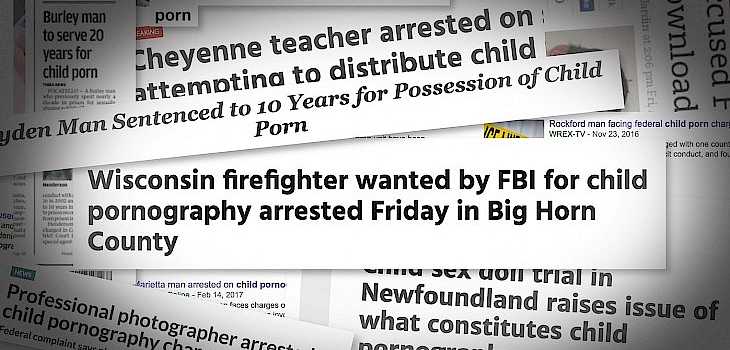Rarely a week goes by in the United States that a child pornographer is not charged or sentenced for federal crimes related to the sexual exploitation of children. The press release headlines above from the Department of Justice were issued on a single day last month.
In coordination with local, state, federal, and international partners—both law enforcement and non-governmental organizations—the FBI devotes extensive resources to fighting the sexual exploitation of children. And while the high number of arrests and convictions speaks to law enforcement’s successes, there is still much work to be done. According to a 2016 Department of Justice report to Congress, “The expansion of the Internet has led to an explosion in the market for child pornography.”
“After you’ve been doing this awhile, you think you’ve seen it all, and then you get a new case,” said Special Agent Eric Campbell, who investigates violent crimes against children in the FBI’s Phoenix Division. “I am surprised by how often I am surprised at what people will do.”
Campbell points to one of his recent cases as an example. In February 2017, a 28-year-old Arizona woman was sentenced to more than five years in prison for mailing child pornography to her imprisoned husband. He was behind bars in Tucson awaiting trial on separate child pornography charges—for which he would eventually receive a 20-year sentence.
Some of the images the woman mailed her husband were of girls as young as 9 years old. “She was trying to sneak them into the prison,” Campbell said, “trying to give her husband what he wanted.”
The FBI coordinates its efforts to protect children through the Violent Crimes Against Children (VCAC) program. The mission is to lower the vulnerability of children to sexual exploitation, to provide a rapid and effective investigative response to such crimes, and to provide appropriate training and other resources to state and local law enforcement partners.
Investigations are conducted in each of the FBI’s 56 field offices by Child Exploitation Task Forces, which combine Bureau resources with those of other federal, state, and local law enforcement agencies. Nearly 400 law enforcement partner organizations participate in these task forces and are assisted by FBI intelligence analysts, victim specialists, and subject matter experts. The task forces also work closely with the National Center for Missing & Exploited Children (NCMEC).
In addition, because the Internet has blurred traditional notions of borders and jurisdiction, the FBI’s legal attaché offices in more than 60 countries around the world coordinate with their foreign counterparts on investigations ranging from child sex trafficking to sex tourism.
Those who engage in the production and distribution of child pornography come from all walks of life and represent varied ages, races, occupations, and education levels. Typically, their crimes are carried out on the so-called dark web—where they can remain anonymous—and their actions are unknown to spouses, families, and associates.
“Most of these guys don’t have any criminal history,” Campbell said, “and no one has any idea of what they were doing until we catch them.” The agent said that the work he and his colleagues do is important, but also emotionally wrenching. “The payoff,” he explained, “is that you are able to uncover these perpetrators and shine a light on them, and do everything possible to make sure they are no longer able to victimize innocent children.”
Shining a Light on Child Pornography
The producers and consumers of child pornography operate in the shadows, and anonymous Internet networks such as Tor often allow them to carry out their illicit activities without fear of being unmasked and caught. Below is a glimpse of the enormity of the problem (compiled in a 2016 report to Congress by the Department of Justice called The National Strategy for Child Exploitation Prevention and Interdiction:
- The FBI’s analysis of one particularly egregious website on Tor found that it hosted approximately 1.3 million images depicting children subjected to violent sexual abuse. Analysis of these specific files identified at least 73 new victims previously unknown to law enforcement.
- NCMEC estimated that more than 26 million sexual abuse images and videos were reviewed by their analysts in 2015. Additionally, NCMEC reported that since 2002, more than 10,500 victims depicted in child pornography have been located and identified by law enforcement. According to NCMEC, 4.4 million CyberTipline reports were submitted in 2015.
- Between 2011 and 2014, researchers from the University of Massachusetts-Amherst looked at five of the most common peer to peer (P2P) networks used to trade child pornography. They estimated that three in 10,000 Internet users on these five P2P networks worldwide were sharing known child pornography in a given month. They also estimated there were 840,000 worldwide unique installations per month of P2P programs sharing child pornography, thus indicating a significant volume of new devices trading confirmed child pornography that connected to at least one of the P2P networks analyzed for the first time.
- An FBI investigation of a single website hosted on Tor had approximately 200,000 registered users and 100,000 individuals had accessed the site during a 12-day period.
Resources
Last Update: Apr 26, 2017 2:37 pm CDT

















